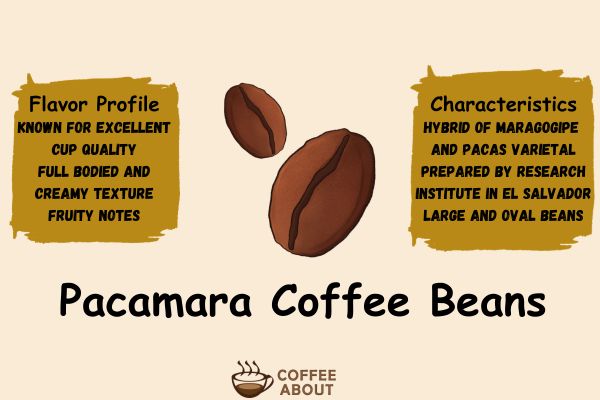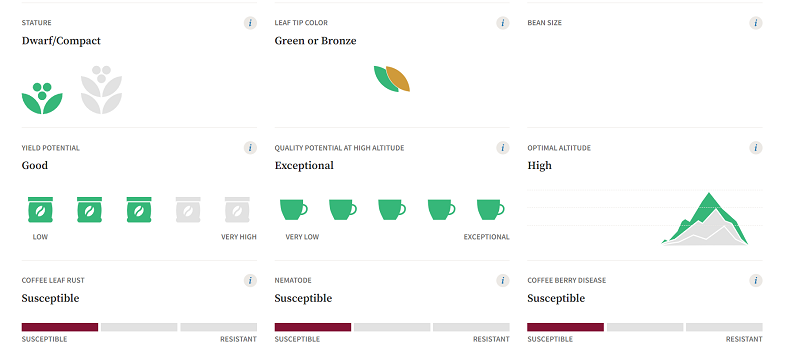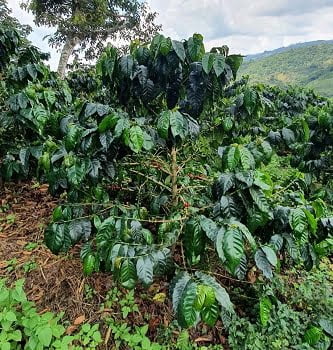Pacamara Coffee Varietal is made from Borbon-Typica hybridization, part of the Coffea Arabica Family. Its origins can be traced to a cross between two older varieties – Pacas and Maragogipe.
If you’re a coffee lover, you’ve probably heard whispers of a varietal called Pacamara making waves in specialty coffee circles.
Pacamara coffee beans offer exceptional cup quality. Their complex flavor, rich aroma, and smooth finish are unparalleled. These beans frequently dominate Cup of Excellence competitions in El Salvador.

How did the Pacamara variety originate?
The origins of the Pacamara variety trace back to a deliberate and innovative initiative by the Salvadoran Institute for Coffee Research (ISIC) in 1958.
It is not a natural mutation but rather a carefully crafted hybrid resulting from the crossbreeding of Pacas and Maragogipe varietals From the Coffea Arabica family.
Pacas itself is a natural mutation of the renowned Bourbon varietal. It’s a compact, high-yielding tree known for its complex flavor and hearty disease resistance.
Maragogipe on the other hand is a quirky mutation of the Typica varietal, known for its large beans and an aromatic, tea-like brew.
By crossing these two, ISIC hoped to blend the best traits of each into one superior hybrid.

What are the Characteristics of Pacamara Coffee?
Pacamara grows into a medium-sized coffee tree with thick foliage and large, dark green leaves. It produces elongated cherries with a little nub on the end, containing its signature extra-large oval beans.

While it delivers complex flavor, Pacamara plants are actually quite delicate.
They have high susceptibility to leaf rust disease and the dwarf trees can be unstable, with varying traits from one generation to the next.
Some farmers struggle with the challenges of cultivating Pacamara as it requires extra care and maintenance.
But for those who can nurture these temperamental trees can fetch extra effort payoffs. A bag of Pacamara coffee beans often sells for 3-5 times the price of regular coffee beans.
Where is Pacamara Coffee grown?
Pacamara is definitely a mountain coffee! The dwarf trees thrive best at high altitudes of 4,000 feet and above.
This specialty bean originates from El Salvador, where the ISIC research institute first cultivated it. They then distributed Pacamara to coffee farmers across Latin America who were interested in growing this new hybrid.
So while El Salvador remains an important producer, you can also find Pacamara growing in the highlands of Guatemala, Costa Rica, and Colombia today.
Wherever it’s cultivated, Pacamara does best in cooler temperatures and rich volcanic soil, allowing its signature sweetness and complex flavors to develop fully.

Also Read: What Country has the best Coffee
What does Pacamara Coffee taste like?
Pacamara coffee delivers an absolutely exquisite cup quality! It has a full-bodied and deliciously creamy texture bursting with sweet flavors like butterscotch, cinnamon, and rich chocolate. You’ll also detect some juicy fruit tones like red berries and stone fruits.
I’ve tried Pacamara from El Salvador and let me tell you – it was a truly decadent experience! The tasting notes were spot on with cinnamon, orange, and plum coming through.
The quality of Pacamara Coffee is often compared with World famous Panamian Geisha Coffee but they are available at a much cheaper price compared to Geisha. According to Perfect Daily Grind:
Along with Gesha, the Pacamara variety consistently receives some of the highest scores at the CoE El Salvador competitions thanks to its exceptional cup quality. However, its beans are very large, which can pose challenges for roasters.
Roasting and Brewing Pacamara Coffee
Pacamara beans are often roasted light to preserve their complex flavor profile and delicate fruity notes. Too dark of a roast can overwhelm the subtle nuances that make Pacamara special.
I really like my Pacamara brewed with the pour-over method, using a medium grind size to bring out its crisp acidity and creamy body.
Slow drip methods allow you to fully savor Pacamara’s complex flavors in each sip.
Never mask this exquisite coffee with milk or sugar either!
I only drink Pacamara black to experience the complete spectrum from bright citrus tones to caramel sweetness.
Discover Guides on other Coffee bean Varieties:
Final Thoughts
And there you have it – the full story on the up-and-coming coffee rockstar known as Pacamara! From its innovative origins to the extra care it needs to thrive, I hope you now feel like a Pacamara expert.
I’d love to hear about your experience with Pacamara in the comments. Feel free to share your favorite tasting notes or brewing tips!
Check out a guide on different coffee beans types





